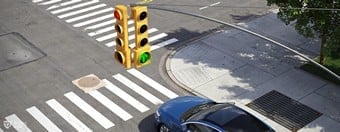

All your missed questions are saved
automatically for extra practice.




It's a practice test that's automatically made up of all your missed questions. Once you finish this test, you’ll be able to revisit your Challenge Bank™ to practice and sharpen your skills.
View All PlansAdding difficult questions to Challenge Bank™ is an exclusive Premium feature. Unlock access to 650+ exam-like questions, a Pass Guarantee, personalized study plans, and more.
View All PlansFree Minnesota DMV Permit Practice Test 2026
| 90-100 | => | 12% |
| 80-89 | => | 18% |
| 70-79 | => | 24% |
| 60-69 | => | 23% |
| <60% | => | 23% |
This Minnesota practice test is current for January 2026 to cover 20 of the most crucial road signs and traffic rules from the official 2026 MN Driver Handbook. In Minnesota, what most people call the “DMV” is officially DVS (Driver and Vehicle Services). You’ll take the Class D Knowledge Test – often called the knowledge or written test. The real Class D knowledge exam contains multiple-choice questions, and you need at least 32 correct answers to pass (with a passing score of 80% or higher). Known as the Minnesota permit test, DVS knowledge exam, or simply the driver’s knowledge test, this practice set closely mirrors the actual format to boost your chances of success. Common challenges faced by test-takers in Minnesota often include misidentifying traffic signs, misunderstanding specific state road rules, and neglecting to study safe driving practices. Bring all required documents to the test center, including your identification, proof of residency, and any necessary fees. Arrive early to allow time for check-in and to calm any nerves. Read each question carefully, considering all answer choices before selecting your response. Stay calm and focused throughout the test. Remember, the more prepared you are, the more confident you’ll feel. Keep your mistakes to a minimum, as the passing limit is set at 8 errors or fewer. Trust in your preparation and approach each question methodically. We highly recommend using our practice tests and the Minnesota Driver’s Manual to ensure a solid understanding of the material and maximize your chances of passing on your first attempt.


Reviewed for legal and handbook accuracy
M.S., Chief Educational Researcher (ACES member)
Last verified for accuracy on
How to use this practice test
- Start here. One of 4 free Minnesota tests. ~6 min. Read explanations as you go.
- Cover more ground. All tests have different questions - no repeats.
- Finish strong. Try the Exam Simulator for a full-length run.
Why this works
- Exam-like questions from the current handbook + questions most people get wrong. Explanations cite the manual.
- AI Assistant explains like a friend.
- Performance Insights shows where you need work.
- Challenge Bank™ saves your mistakes for targeted practice.
Actual DVS permit test: What to expect?
- Where: Any Minnesota DVS office (find locations)
- Bring: ID + SSN + residency proof + permit/license fee (see checklist)
- If you fail: Separate fee per each retake attempt.
- Top reasons for failure: yielding to pedestrians and bicyclists, roundabouts and lane usage.
- Ready to schedule? Book your MN DVS appointment
Real Minnesota drivers who passed first try
Verified student reviews • Shared with permission
More MN DVS written exam resources
Are you in another state?
- Alabama
- Alaska
- Arizona
- Arkansas
- California
- Colorado
- Connecticut
- Delaware
- District of Columbia
- Florida
- Georgia
- Hawaii
- Idaho
- Illinois
- Indiana
- Iowa
- Kansas
- Kentucky
- Louisiana
- Maine
- Maryland
- Massachusetts
- Michigan
- Minnesota
- Mississippi
- Missouri
- Montana
- Nebraska
- Nevada
- New Hampshire
- New Jersey
- New Mexico
- New York
- North Carolina
- North Dakota
- Ohio
- Oklahoma
- Oregon
- Pennsylvania
- Rhode Island
- South Carolina
- South Dakota
- Tennessee
- Texas
- Utah
- Vermont
- Virginia
- Washington
- West Virginia
- Wisconsin
- Wyoming
We know what it takes to pass. And we’ve got the proof.
Driver’s Ed is - nobody wants to set foot inside the DVS. That’s why millions of learners trust us for simple, visual, effective prep.
An official & trusted partner in driver education
We are an officially recognized FMCSA Entry-Level Driver Training provider and a proud partner to over 2,500 libraries. We work with safety organizations like GHSA and the National Safety Council to help create safer roads for everyone.






A smarter way to study
Challenge Bank™
Our trademarked system automatically saves questions you miss, creating personalized tests that target your weak spots until you’ve mastered the material.
AI-powered feedback
Get smarter as you study. Our new AI-powered feedback provides detailed, question-level insights to help you understand the why behind each answer.
Interactive handbook
Go beyond the boring black-and-white manual. Our interactive handbook lets you read, listen with an MP3 audio version, or even chat with it to find the information you need, faster.
We build our practice questions from the current 2026 MN Driver Handbook and refine them using patterns recent test‑takers report.
Driver handbook • Knowledge‑test/permit overview • Fees & ID requirements • Office/appointment info
We mirror recurring themes (e.g., right‑of‑way traps, sign look‑alikes) and use similar distractors and wording styles.
We don’t collect or publish actual test items and we’re not affiliated with DVS.

